3.2: Bronze Age- Xia Dynasty (2070 BCE – 1600 BCE)
- Page ID
- 219964
\( \newcommand{\vecs}[1]{\overset { \scriptstyle \rightharpoonup} {\mathbf{#1}} } \)
\( \newcommand{\vecd}[1]{\overset{-\!-\!\rightharpoonup}{\vphantom{a}\smash {#1}}} \)
\( \newcommand{\id}{\mathrm{id}}\) \( \newcommand{\Span}{\mathrm{span}}\)
( \newcommand{\kernel}{\mathrm{null}\,}\) \( \newcommand{\range}{\mathrm{range}\,}\)
\( \newcommand{\RealPart}{\mathrm{Re}}\) \( \newcommand{\ImaginaryPart}{\mathrm{Im}}\)
\( \newcommand{\Argument}{\mathrm{Arg}}\) \( \newcommand{\norm}[1]{\| #1 \|}\)
\( \newcommand{\inner}[2]{\langle #1, #2 \rangle}\)
\( \newcommand{\Span}{\mathrm{span}}\)
\( \newcommand{\id}{\mathrm{id}}\)
\( \newcommand{\Span}{\mathrm{span}}\)
\( \newcommand{\kernel}{\mathrm{null}\,}\)
\( \newcommand{\range}{\mathrm{range}\,}\)
\( \newcommand{\RealPart}{\mathrm{Re}}\)
\( \newcommand{\ImaginaryPart}{\mathrm{Im}}\)
\( \newcommand{\Argument}{\mathrm{Arg}}\)
\( \newcommand{\norm}[1]{\| #1 \|}\)
\( \newcommand{\inner}[2]{\langle #1, #2 \rangle}\)
\( \newcommand{\Span}{\mathrm{span}}\) \( \newcommand{\AA}{\unicode[.8,0]{x212B}}\)
\( \newcommand{\vectorA}[1]{\vec{#1}} % arrow\)
\( \newcommand{\vectorAt}[1]{\vec{\text{#1}}} % arrow\)
\( \newcommand{\vectorB}[1]{\overset { \scriptstyle \rightharpoonup} {\mathbf{#1}} } \)
\( \newcommand{\vectorC}[1]{\textbf{#1}} \)
\( \newcommand{\vectorD}[1]{\overrightarrow{#1}} \)
\( \newcommand{\vectorDt}[1]{\overrightarrow{\text{#1}}} \)
\( \newcommand{\vectE}[1]{\overset{-\!-\!\rightharpoonup}{\vphantom{a}\smash{\mathbf {#1}}}} \)
\( \newcommand{\vecs}[1]{\overset { \scriptstyle \rightharpoonup} {\mathbf{#1}} } \)
\( \newcommand{\vecd}[1]{\overset{-\!-\!\rightharpoonup}{\vphantom{a}\smash {#1}}} \)
\(\newcommand{\avec}{\mathbf a}\) \(\newcommand{\bvec}{\mathbf b}\) \(\newcommand{\cvec}{\mathbf c}\) \(\newcommand{\dvec}{\mathbf d}\) \(\newcommand{\dtil}{\widetilde{\mathbf d}}\) \(\newcommand{\evec}{\mathbf e}\) \(\newcommand{\fvec}{\mathbf f}\) \(\newcommand{\nvec}{\mathbf n}\) \(\newcommand{\pvec}{\mathbf p}\) \(\newcommand{\qvec}{\mathbf q}\) \(\newcommand{\svec}{\mathbf s}\) \(\newcommand{\tvec}{\mathbf t}\) \(\newcommand{\uvec}{\mathbf u}\) \(\newcommand{\vvec}{\mathbf v}\) \(\newcommand{\wvec}{\mathbf w}\) \(\newcommand{\xvec}{\mathbf x}\) \(\newcommand{\yvec}{\mathbf y}\) \(\newcommand{\zvec}{\mathbf z}\) \(\newcommand{\rvec}{\mathbf r}\) \(\newcommand{\mvec}{\mathbf m}\) \(\newcommand{\zerovec}{\mathbf 0}\) \(\newcommand{\onevec}{\mathbf 1}\) \(\newcommand{\real}{\mathbb R}\) \(\newcommand{\twovec}[2]{\left[\begin{array}{r}#1 \\ #2 \end{array}\right]}\) \(\newcommand{\ctwovec}[2]{\left[\begin{array}{c}#1 \\ #2 \end{array}\right]}\) \(\newcommand{\threevec}[3]{\left[\begin{array}{r}#1 \\ #2 \\ #3 \end{array}\right]}\) \(\newcommand{\cthreevec}[3]{\left[\begin{array}{c}#1 \\ #2 \\ #3 \end{array}\right]}\) \(\newcommand{\fourvec}[4]{\left[\begin{array}{r}#1 \\ #2 \\ #3 \\ #4 \end{array}\right]}\) \(\newcommand{\cfourvec}[4]{\left[\begin{array}{c}#1 \\ #2 \\ #3 \\ #4 \end{array}\right]}\) \(\newcommand{\fivevec}[5]{\left[\begin{array}{r}#1 \\ #2 \\ #3 \\ #4 \\ #5 \\ \end{array}\right]}\) \(\newcommand{\cfivevec}[5]{\left[\begin{array}{c}#1 \\ #2 \\ #3 \\ #4 \\ #5 \\ \end{array}\right]}\) \(\newcommand{\mattwo}[4]{\left[\begin{array}{rr}#1 \amp #2 \\ #3 \amp #4 \\ \end{array}\right]}\) \(\newcommand{\laspan}[1]{\text{Span}\{#1\}}\) \(\newcommand{\bcal}{\cal B}\) \(\newcommand{\ccal}{\cal C}\) \(\newcommand{\scal}{\cal S}\) \(\newcommand{\wcal}{\cal W}\) \(\newcommand{\ecal}{\cal E}\) \(\newcommand{\coords}[2]{\left\{#1\right\}_{#2}}\) \(\newcommand{\gray}[1]{\color{gray}{#1}}\) \(\newcommand{\lgray}[1]{\color{lightgray}{#1}}\) \(\newcommand{\rank}{\operatorname{rank}}\) \(\newcommand{\row}{\text{Row}}\) \(\newcommand{\col}{\text{Col}}\) \(\renewcommand{\row}{\text{Row}}\) \(\newcommand{\nul}{\text{Nul}}\) \(\newcommand{\var}{\text{Var}}\) \(\newcommand{\corr}{\text{corr}}\) \(\newcommand{\len}[1]{\left|#1\right|}\) \(\newcommand{\bbar}{\overline{\bvec}}\) \(\newcommand{\bhat}{\widehat{\bvec}}\) \(\newcommand{\bperp}{\bvec^\perp}\) \(\newcommand{\xhat}{\widehat{\xvec}}\) \(\newcommand{\vhat}{\widehat{\vvec}}\) \(\newcommand{\uhat}{\widehat{\uvec}}\) \(\newcommand{\what}{\widehat{\wvec}}\) \(\newcommand{\Sighat}{\widehat{\Sigma}}\) \(\newcommand{\lt}{<}\) \(\newcommand{\gt}{>}\) \(\newcommand{\amp}{&}\) \(\definecolor{fillinmathshade}{gray}{0.9}\)Introduction
Before studying the history, population, and geographic movement of developing China and the resultant dynasties, the video is an overview of the early dynasties and their significant events. Although the Xia Dynasty is listed as the first unified dynasty, many scholars today doubt its existence, and the concepts are still debated. The Shang Dynasty was the first documented dynasty. Taking the census was a common event in ancient China, and the early population numbers were between 10 and 20 million from 2000 BCE to 200 BCE. By the time of the Han Dynasty in 200 BCE, the census taking was more rigorous, and the population was 59 million.[1] This was the same period as the Roman Empire, with a population of 4.95 million (excluding enslaved people) in 225 BCE.[2] Ancient China became a center of innovation and new spiritual consciousness.
A historical overview of the Zhou, Qin, and Han dynasties in China.
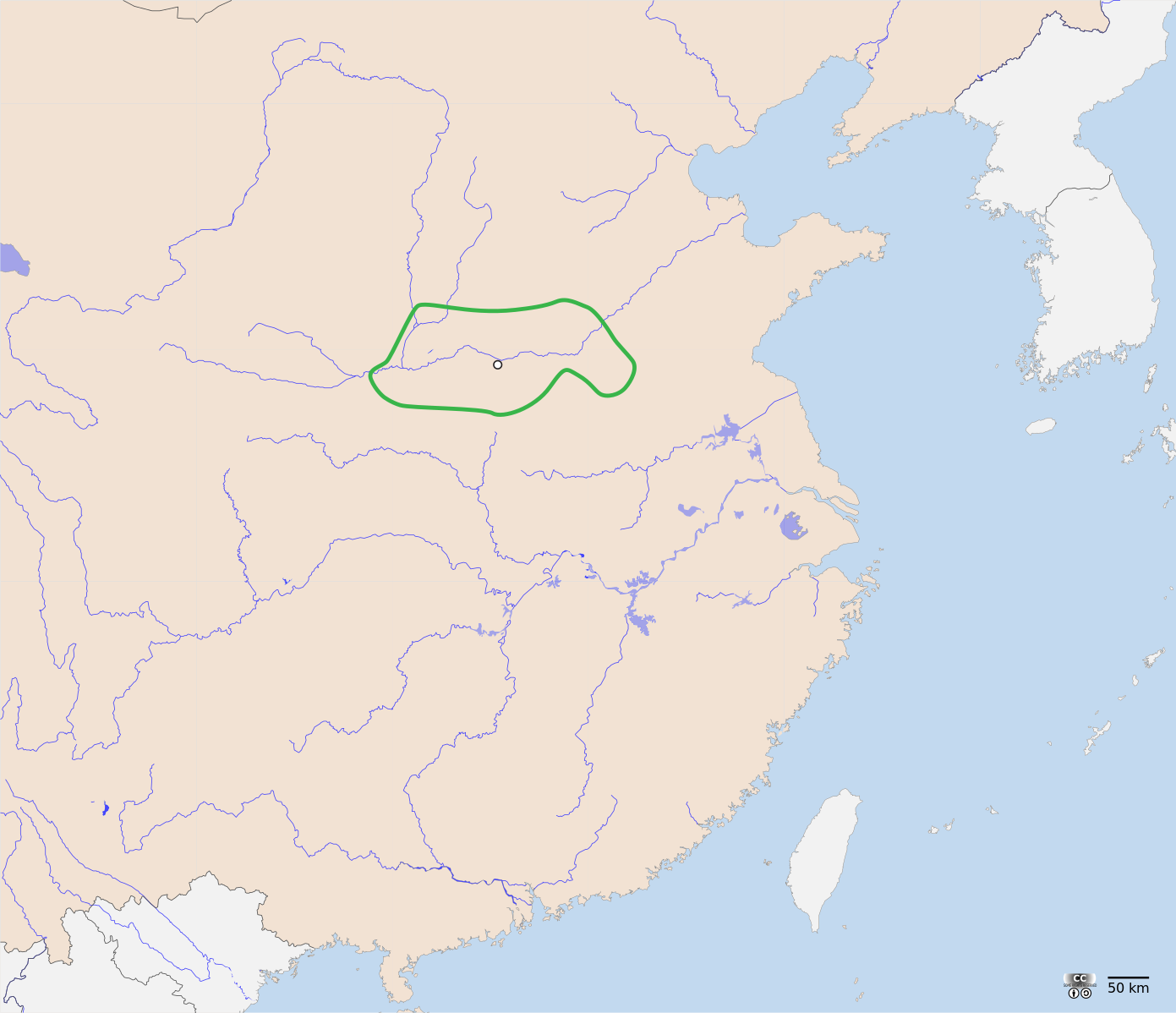
The Xia Dynasty was probably located by the Yellow River in China (3.2.1) as outlined in green on the map. Scholars today question the existence of the dynasty as the documentation is limited. The Xia Dynasty, with Yu as its first king, is believed to mark the beginning of the age of dynasties. Yu, known as Yu the Great (3.2.2). He was depicted on silk by Ma Lin during the Song era. Yu is supposed to have stood by the mighty Yellow River, ready to stop the violent floods that "surged towards the heaven, so vast that they embraced the mountains and covered the hills."[3] Yu toiled for over twelve years to build the dikes, canals, enhanced riverbanks, and diversion routes to help control the river and keep the settlements and farmlands from flooding. When he was finished, he believed "the world was then greatly ordered."[4]
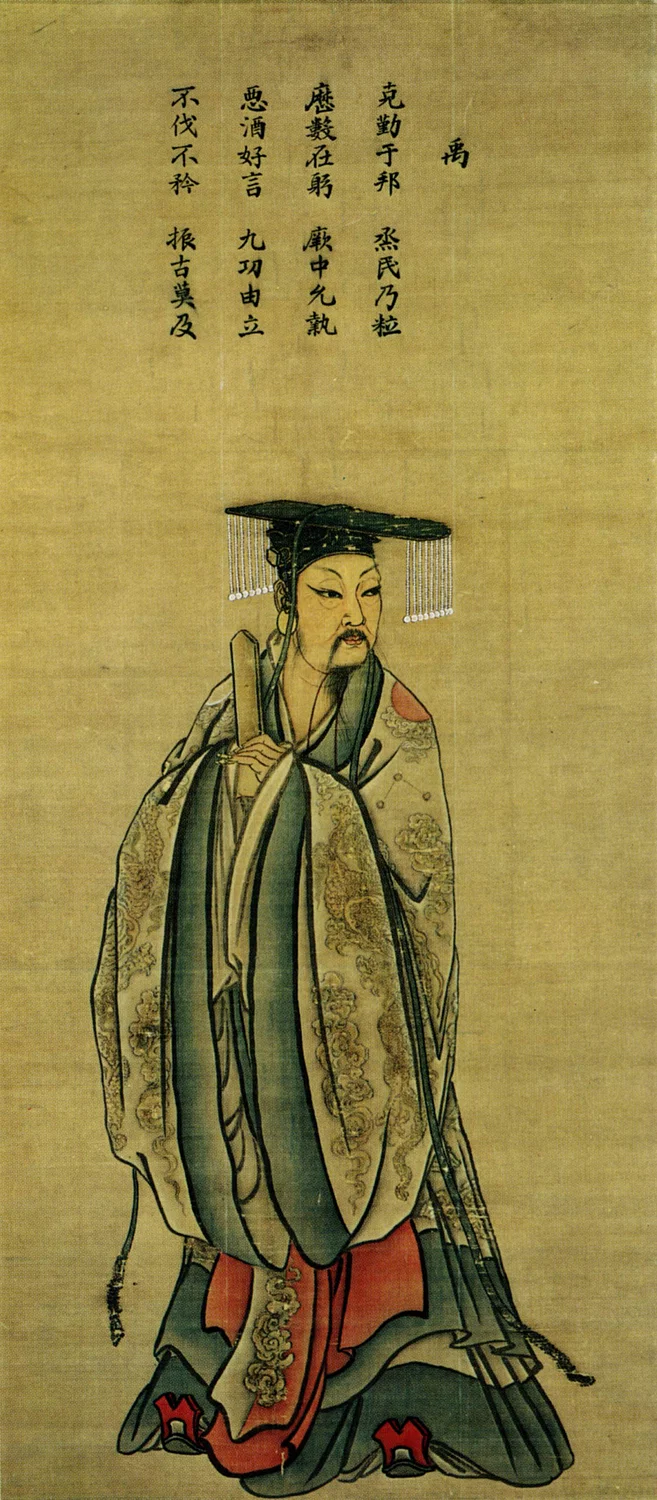
Unlike Mesopotamia, outside forces did not constantly invade the Xia geographic area. However, the dynasties faced threats from within because of the behaviors of the leaders and heirs. In the past, the chieftains of an area were chosen based on merit. Yu was selected because he was worthy, and he, in turn, chose another worthy candidate to lead. However, Yu's son disregarded the deputy and became king himself. "Unfortunately, the powerful patriarchs for the villages…supported Yu's son Qi; it was their will to have a hereditary dynasty. This rebellious action carried the Yellow River settlements from the days of the Sage Kings into an era of blood succession."[5] From Yu onwards, the establishment of the dynasties grew, and the period of the Xia dynasty probably had sixteen different kings. These kings acquired their positions through the system of inherited primogeniture, which also involved an attendant nobility system of elites rather than one based on meritorious succession.
Have you always wondered about the history of the Xia Dynasty? The Xia Dynasty is one of the biggest question marks in Ancient Chinese History, in this video we outline the full history of the Xia Dynasty.
The Xia Dynasty, which emerged in 2070 BCE, presents a unique challenge for historians seeking to construct an accurate account of its history. With limited artifacts surviving from that era, much of our understanding is derived from Sima Qian's "Records of the Grand Historian." Sima Qian, a court astrologer during the Han Dynasty, painstakingly gathered information from various sources, including oral tradition, written records on wood or bamboo, and personal interviews to create a detailed and comprehensive historical narrative.
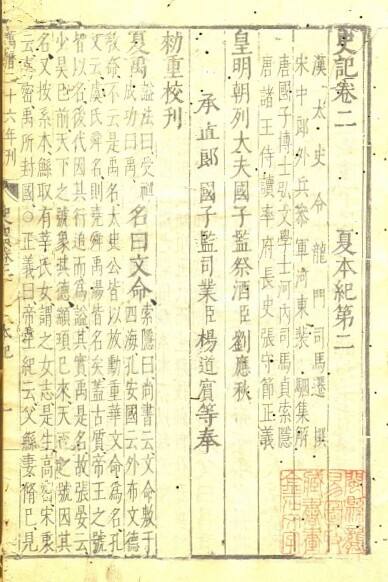
The Basic Annals is a comprehensive historical text consisting of twelve chapters that provide insights into China's ancient past, similar to other well-known ancient Chinese documents. The first five chapters of the Basic Annals present a detailed account of the Xia, Shang, and Zhou dynasties, shedding light on their political and cultural development. Chapter 2 of the Basic Annals (3.2.3) focuses on the Xia Dynasty; however, its accuracy is still questioned because of multiple historical rewrites. Despite this, a historian specializing in the Shang Dynasty has cited it as a valuable resource for understanding the early stages of Chinese civilization:
"It was commonly maintained that Ssuma Chhien [Sima Qian] could not have adequate historical materials for his account of what had happened more than a thousand years earlier. One may judge of the astonishment of many, therefore, when it appeared that no less than twenty-three of the thirty rulers' name were to be clearly found on the indisputably genuine Anyang bones. It must be, therefore, that Ssuma Chhien [Sima Qian] did have fairly reliable materials at his disposal—a fact which underlines once more the deep historical-mindedness of the Chinese—and that the Shang dynasty is perfectly acceptable."[6]
The discovery of oracle bones from the Shang dynasty during the early 20th century has provided invaluable insight into the ancient Chinese civilization. These bones were inscribed with divinations and questions that were posed to the gods, and the answers were interpreted by the diviners. The interpretation of these inscriptions has confirmed the accuracy of the historical records documented by Sima Qian in his Records of the Grand Historian, which is considered one of the most important works of ancient Chinese literature. The discovery of these oracle bones has not only shed light on the religious practices of the Shang dynasty has also given us a better understanding of their political and social structures.
Architecture
Recently, archaeologists have discovered ruins, which are believed to be the capital (3.2.4) of the Xia dynasty. The information gleaned from these ruins has been incredibly valuable in understanding this dynasty's potential culture and structure. Among the ruins was the foundation of a large palace, which was likely built using rammed earth and featured a single courtyard and gate. Despite its unassuming appearance, this palace was an important find for researchers, as it suggested how the buildings of the Xia dynasty were constructed. In addition to this palace, other palaces were also uncovered, along with wide roads connecting them, tombs filled with pottery, bronze, jade, and wooden drainage culverts. Nearby, a large bronze smelting facility was also discovered and probably used for the large-scale manufacturing of vessels and weapons.
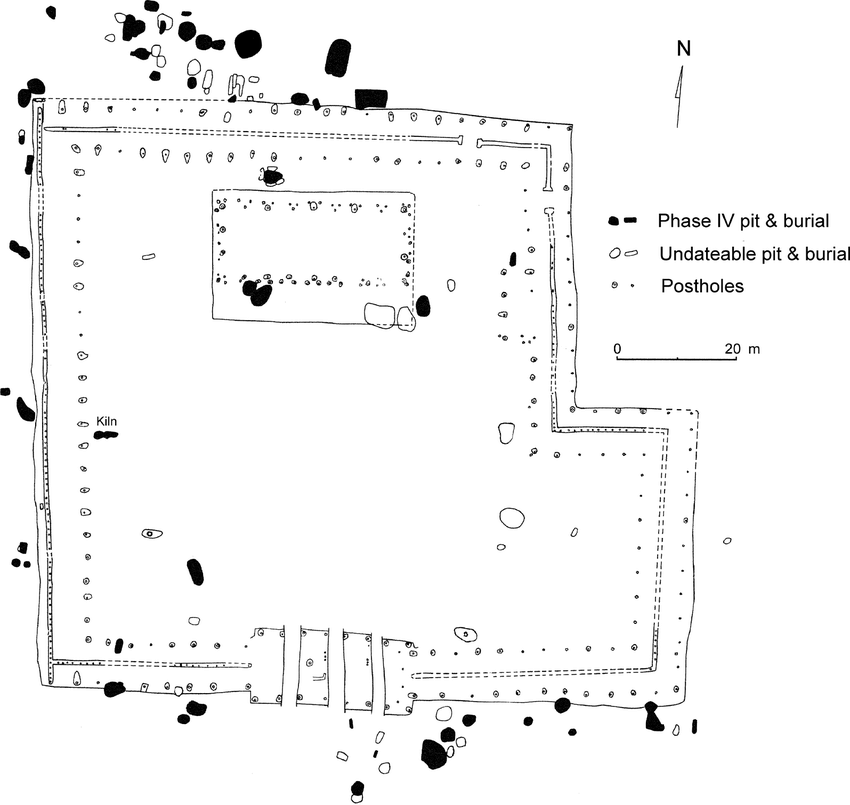
Art
During the Bronze Age, the inhabitants of the Yellow River valley devoted their time and effort to creating stunning vessels for practical use and ritual and ancestor worship purposes. Unlike other civilizations that mainly utilized bronze for weapons and tools, the people of this region used their technical and artistic expertise to produce remarkable and enduring metal pieces symbolizing their affluence and influence. They employed the piece-mold casting technique, which involved casting smaller components before integrating them into larger molds, allowing for the creation of intricate and elaborate bronze objects. These bronze objects not only served as functional items but also as works of art that showcased the creativity and skill of their creators. The beauty and remarkable craftsmanship of these bronze objects have managed to withstand the test of time, remaining intact for centuries and providing us with a glimpse into the cultural heritage of this ancient civilization.
The bronze wine goblet (3.2.5) was balanced on three legs and had a tubular spout for pouring. The handle, spout, and legs were cast separately and then included in the mold for the vessel's body. The vessel was from the late Xia and was generally used for rituals. They also used clay to create ordinary pottery for daily use and decorated vessels for specific rituals. The pottery vessel (li), with its wide mouth used for cooking (3.2.6), has the same three-leg structure as the wine goblet. The sides were incised with a typical decorative pattern of geometric forms.
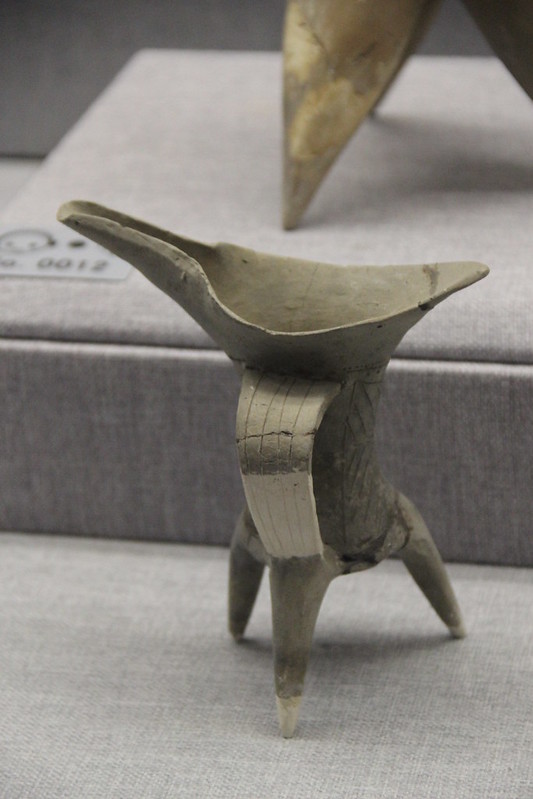

Written Language
The first kind of known calligraphy started in this period and these symbols were found on ceramic pieces, a material hard enough to survive the ages. The words were simple representational lines that later evolved into a complex language. Based on historical records, the Xia dynasty is thought to have reigned from approximately 2070 BCE to 1600 BCE. The final ruler was infamous for his corrupt and tyrannical behavior, indulging in extravagant living and excessive drinking. His cruelty caused widespread animosity among his subjects and neighboring territories, with reports of him even executing his ministers over minor issues. Despite being under the Xia's control, the Tang of Shang vigilantly observed the chaos as the dynasty spiraled into turmoil, waiting for his time to act.
[1] An overview of the geographic distribution of the population in China.
[2] The Demography of Roman Italy: Population Dynamics in an Ancient Conquest Society (201 BCE – 14 CE)
[3] Neinhauser, W. (1994). Ssu-ma Ch’ien, The Grand Scribe’s Records, Vol. 1 ed. translated by Tsai-fa Cheng et al. 21.
[4] Neinhauser, W. (1994). Ssu-ma Ch’ien, The Grand Scribe’s Records, Vol. 1 ed. translated by Tsai-fa Cheng et al. 32.
[5] Bauer, S. (2007). The history of the ancient world from the earliest accounts to the fall of Rome. W. W. Norton, 166.
[6] Joseph, N. (1954). Science and civilization in China: Volume 1, introductory orientations. Cambridge University Press. (p. 88).


